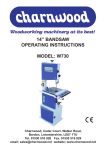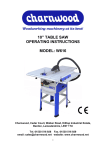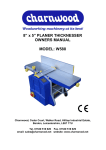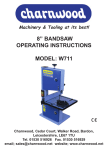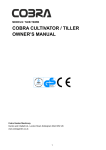Download Charnwood W625 Owner`s manual
Transcript
TABLE SAW OPERATORS MANUAL MODEL: W625 Charnwood, Cedar Court, Walker Road, Hilltop Industrial Estate, Bardon Hill, Leicestershire, LE67 1TU Tel. 01530 516 926 Fax. 01530 516 929 email: [email protected] website: www.charnwood.net GENERAL SAFETY RULES WARNING: Do not attempt to operate the machine until you have read thoroughly and understood completely all instructions, rules, etc. contained in this manual. Failure to comply may result in accidents involving fire, electric shock, or serious personal injury. Keep this owner's manual and review frequently for continuous safe operation. 1. Know your machine. For your own safety, read the owner's manual carefully. Learn its application and limitations, as well as specific potential hazards pertinent to this machine. 2. Make sure all tools are properly earthed. 3. Keep guards in place and in working order. If a guard must be removed for maintenance or cleaning, make sure it is properly replaced before using the machine again. 4. Remove adjusting keys and spanners. Form a habit of checking to see that the keys and adjusting spanners are removed from the machine before switched it on. 5. Keep your work area clean. Cluttered areas and workbenches increase the chance of an accident.' 6. Do not use in dangerous environments. Do not use power tools in damp or wet locations, or expose them to rain. Keep work areas well illuminated. 7. Keep children away. All visitors should be kept a safe distance 8. from the work area. 9. Make workshop childproof. Use padlocks, master switches remove starter keys. and 10. Do not force the machine. It will do the job better and be safer at the rate for which it is designed. 11. Use the right tools. Do not force the machine or attachments to do a job for which they are not designed. Contact the manufacturer or distributor if there is any question about the machine's suitability for a particular task. 12. Wear proper apparel. Avoid loose clothing, gloves, ties, rings, bracelets, and jewellery which could get caught in moving parts. Non-slip footwear is recommended. Wear protective hair covering to contain long hair. 13. Always use safety glasses. Normal spectacles only have impact resistant lenses. They are not safety glasses. 14. Do not over-reach. Keep proper footing and balance at all times. 15. Maintain the machine in good condition. Keep the machine clean for best and safest performance. Follow instructions for lubrication and changing accessories. 16. Disconnect the machine from power source before servicing and when changing the blade. 17. Never leave the machine running unattended. Turn the power off. Do not leave the machine until it comes to a complete stop. 18. Do not use any power tools while under the effects of drugs, alcohol or medication. 19. Always wear a face or dust mask if operation creates a lot of dust and/or chips. Always operate the tool in a well ventilated area and provide for proper dust removal. Use a suitable dust extractor. ADDITIONAL RULES FOR CIRCULAR SAWS 1. Ensure that the saw table is clear of off-cuts, tools or anything else that might foul the work-piece. 2. If your saw has a dust extractor hose connected to the crown guard, ensure that it is held clear of the table and will not foul the work-piece as it passes over the table. 3. When cutting large sheets of material or long boards use one or more roller stand(s) to support the work or have a competent helper to support it as it feeds off the rear of the table. 4. Never use the saw without the riving knife and check that it is in line with the blade before using the saw. 5. Always use a brush to clear the table of dust or debris. NEVER use your hands, especially when the machine is running. 6. ALWAYS USE A PUSH STICK WHEN IT IS NECESSARY TO PUSH ANY PIECE OF MATERIAL OF SUCH SIZE THAT IT WOULD BRING YOUR HANDS WITHIN 30 CM OF THE BLADE. 7. Do not cut material that is badly warped or which has screws or nails in it 8. Be extra vigilant when cutting stock which has loose knots in it as these may fly out of the saw. 9. NEVER remove the table insert when the saw is running. 10. To avoid exposure to hazardous dust, do not use this saw without connecting it to a suitable dust extractor. 11. Always work with a sharp saw blade and feed the work at a rate suited to the thickness and hardness of the material. Note: This table saw has been designed and built solely as a woodworking machine. Do not modify it in any way or use for anything other than its designated purpose. Neither the manufactures nor the supplies are liable for any damage or injury caused by incorrect assembly, operation or electrical connection of this machine. Specification Table size 550(w) x 1600(d)mm Table size with optional table extension 950(w) x 1600(d)mm Table height 800mm Motor (carbon brush) 1600W, 240v single phase 300mm (12”) 30mm Blade diameter and bore Blade rotation speed (no load) 3000 rpm Maximum depth of cut at 90o 60mm Maximum depth of cut at 45o 40mm Maximum cutting width 290mm (12”) Cutting width with optional table extension 690 mm (27”) Dust extractor hose connection 100mm Dimensions (WxDxH) 600mm x 1690mm x 1050mm Weight 60 kg Rating Trade (Note: Imperial measurements approximate) Risk of Injury! Never reach into the running saw blade. Wear Eye Protection Wear Ear Protection Rating Description Trade: Suitable for daily use by professional woodworkers. Continuously rated, high power and a heavy duty construction. Typically used by several different operators in a small or medium sized business. Will be used up to the machines maximum limit with some long work periods. Expected maximum use of 1000 hours annually. Unpacking This saw is best unpacked on the floor as it is quite heavy. Open the carton, carefully unpack all of the contents and lift the body of the saw onto a bench, leaving it inverted. Familiarise yourself with the parts and take the time to sort out the various types of nuts and bolts. Assembly Leave all bolts finger tight until assembly of the legs is completed. Locate the leg with the square hole cut out for the NVR switch and place it on the table as shown, inside the turned down edges of the table. Secure the leg with 4 bolts. M6 x 16mm long bolts with washes and nuts. Repeat for the other 3 legs Next, bolt on the four braces which fit half way down each leg. There are 2 long rails and 2 short rails. Bolt the four rails together as shown, using three M6 x 16mm bolts with washers and nuts in each corner. It does not matter which pair, the long or the short are on top but please keep this symmetrical. Place the four black rubber feet on the legs. True up the assembly and tighten all the bolts. Locate the rear extension table. Attach the two support braces, using four M6 x 16mm bolts with washers and nuts. Noting that they fit inside the table and on top of the floor stand rail. Locate the ripping fence guide rail and bolt it onto the front of the table. Use an M6 x 16mm bolt with washer and nut. At the other end of the fence guide rail, use a longer bolt M6 x 20mm. Note how there is a cut out in the guide rail which fits over a bolt head. Offer up the NVR switch and fix it in place with the two self tapping screws provided. Bolt on the dust extractor port noting that the side entry faces away from the motor. Use four M3 x10mm long bolts. Fit the wheels using four M6 x 16mm bolts with washers and nuts. Adjust them, so that the wheels are just clear of the ground when all four feet are supporting the saw. The wheels will make contact with the floor and take the weight of the saw when it is lifted by means of the handles, which will be fitted later. Raise the blade by turning the handle at the front of the saw (See Using the Table Saw on page 13) Locate the crown guard, loosen the bolt near the dust port and fit the guard to the riving knife. The bolt will slide into the slot at the top of the knife. When it is fully seated, retighten the bolt. Loosen the two bolts at the right, rear of the table and slot in the dust hose support. Retighten the bolts. Fit one end of the dust collection hose to the spigot on the back of the crown guard, fit the other end to the side inlet of the dust extractor port and clip the middle into the support bracket you have just fitted. Bolt on the two lifting handles, using two M6 x 16mm bolts, washers and nuts for each one. Fit the hook to the front right leg, which is used to hang the push stick. Locate the fence carrier assembly and the L shaped fence. Assemble the fence by sliding two square head bolts into the T-slot in the extrusion, passing them through the vertical face of the mitre fence base, securing them with a washer and yellow knob. The black handle is used to lock the fence along the guide rail. When the handle is lifted the fence assembly will slide smoothly along the rail, when the handle is fully depressed the fence is locked in position. This is how the completed fence should look. With it mounted on the front rail and the adjustable mitre gauge set to 0° it can be used as a rip fence. When mounted on the left hand side rail, the mitre angle can be set for crosscutting, up to 60 degrees each way. Rip fence Mitre fence Optional Side Extension Table If you have purchased the optional right hand extension table; Bolt the two support braces to the right hand side floor stand rail. This gives support to the table while you are attaching it. Push a bolt through each of the two holes adjacent to the legs. Place a washer and nut on the back end. Leave them loose and with a good length of the bolt protruding on the outside of the table. Slot the table over the two protruding bolts and support the outer edge by guiding the braces so that they sit inside the turned down edge of the extension table, as shown. Level the extension table to the main table and tighten all the bolts. Optional Sliding Carriage Note: If installed, remove the mitre fence guiderail which is bolted to the left hand side of the table. Unpack the components and familiarise yourself with them. Identify the front and rear guide rail carriers. Fit one to each end of the left hand side of the table, as shown. Note that the front and rear are different. To install the carrier, remove two of the bolts which secure the leg to the table. Refit them with the carrier on the outside of the table. Next, bolt on the two support brackets, using three bolts, with washers and nuts, as shown. Use the larger M8 bolt here. Slide the carriage table assembly onto the guide rail, as shown. There are 6 bearings which sit in contact with the guide rail. They are a tight fit so you may need to push to get it started. The lower pair of bearings can be adjusted to get a tight fit against the guide rail as necessary. Fix the guide rail to the carriers with the four hex socket head bolts provided. Note that the front end of the guide rail, will project about 110mm in front of the main table. Fit the remaining two cap head bolts through the ends of the rail. These will act as travel limit stops for the carriage and prevent the table from coming off the end of the rail. Setting The Sliding Table Firstly set the height: These holes are slotted so that the carrier may be adjusted up or down to bring the sliding carriage to the correct height. Ideally it will be just proud of the table (0.5mm to 1mm) to allow the work piece to easily slide over the main table. Next set the level: Use this bolt to level the carriage. Turning the bolt clockwise, will lift the left hand side of the table. Once a good level has been achieved tighten the nut up against the face of the guide rail carrier to lock it. Use a straight edge (or the fence carrier that you have removed) to check the level of the sliding table. Here you see a carriage that needs adjusting. Keep adjusting the bolts until the sliding table and the main table are correctly aligned. Take the pivot bolt, M10 x 65mm, place an M10 steel washer over the bolt and then pass the bolt through the fence support. Next place a black plastic washer onto the bolt and then screw the bolt into the threaded hole in the sliding table. The plastic washer sits between the fence support and the sliding table. Tighten the bolt securely but check the fence can still pivot freely around this point. Take the locking handle, place a steel washer over the bolt and then pass the bolt through the fence support. Next place a black plastic washer onto the bolt and then pass the bolt through the hole in the sliding table. Secure the bolt with a steel washer and nyloc nut. The plastic washer sits between the fence support and the sliding table. Use a spanner to adjust the nyloc nut so that when the locking handle is pressed down the fence will not pivot. When the handle is lifted the fence should swing around pivot point. Slide the heads of the two bolts, M6 x 45mm, into the Tslot of the mitre fence extrusion, pass them through the fence support and secure them with washers and the two black plastic wing nuts. There is an adjustable, flip-over length stop on the fence, to speed up repetitive work. Use a set square to set the mitre fence extrusion at 90 degrees to the blade. The mitre scale has two fixing screws which can be loosened to make an adjustment to the scale if necessary. Next set the 90 degree return stop. The round silver stop, has a fixing bolt drilled off centre. With the fence still locked at the 90 degree position, loosen the fixing bolt and rotate the stop until it touches the back of the fence support. Tighten the fixing bolt. Using The Table Saw Start / Stop Switch Blade Angle Scale Blade Angle Locking Knob Blade Height Scale Blade Height Adjustment Handle On/Off Switch To turn the saw on, press the green button. Wait for the blade to reach its maximum speed of rotation before commencing with the cut. To turn the machine off again, press the red button. The machine is fitted with an NVR (No Voltage Release) switch. This type of switch is designed so that if the machine is disconnected from the mains whilst running and then reconnected, the motor will not automatically restart. Cutting Depth Adjustments to the cutting depth should be made only when the saw is not running. Turn the crank handle to set the blade to the required depth. Turn anticlockwise to lower the blade, turn clockwise to raise the blade. The blade height should always be set so that only the carbide tips of the blade (approx. 5mm) projects above the wood. Angle of Cut Adjustments to the angle of cut should be made only when the saw is not running. To tilt the blade for making bevel cuts, there are 2 locking knobs. Loosen both of the yellow knobs, located at the front and the rear of the machine. Push the bottom blade housing around to the required angle, a scale is provided for guidance. Lock the angle by tightening both of the yellow knobs. Cutting Width The rip fence is used to make longitudinal (with the grain) cuts. Set the fence to the required dimension by measuring with a rule between the fence and the blade. Clamp the fence in place by firmly pressing down the locking lever. To avoid kickback, the far end of the fence extrusion should be set correctly. The fence extrusion should be set so that the end is level with the centre of the saw blade. This allows the timber space to expand into, after the cut has been made. When cutting wider pieces the fence extrusion can be moved further towards the back of the blade, in a line projecting at roughly at 45 degrees out from the centre of the blade. Mitre Fence To cut across the grain, use the sliding mitre fence. To set 90 degrees or any other angle, undo the locking handle and rotate the quadrant to the desired angle. Lock the angle setting with the plastic handle. The fence extrusion can then be adjusted so thet the end is close to the blade, giving better support to the work piece. When setting the fence, take care to ensure the fence will not contact the blade. Making a cut Ensure there is enough space around the table for the work piece before starting the cut. Position your feet in a stable and balanced stance. When feeding the timber, place your hands on the section of timber being kept. Never hold the waste part of the timber. Never force timber through the saw, always let it cut at its own speed. When cutting narrow pieces - use the push stick. Blade Removal and Replacement Always switch off and unplug the saw before removing or replacing the blade. The table insert panel surrounding the blade is removable to allow access to the interior of the saw. Remove the crown guard and then remove the four screws using a cross head screw driver and lift out the panel. The saw is supplied with 2 spanners. Use the peg spanner to lock into the saw blade flange and hold the blade stationary. Use the 13mm spanner to undo the locking bolt. Please Note: The bolt is Left Hand Thread Turn it clockwise to undo it. Refit the blade, flange and bolt in the same way. Troubleshooting Saw vibrates Check all nuts and bolts for tightness and check that blade is not damaged. Cuts are slow, wood is blackened Examine the blade. If any Tungsten tips are missing or broken the blade should be replaced. If the tips are blunt, the saw blade may be professionally sharpened. Saw stalls Feed rate too high, slow down. Rip fence is not parallel to blade Bring the fence up to the blade and re-align the fence so it is parallel, using the large locking know on the mitre fence base. Lower saw guard fills with dust It is essential to use a vacuum extractor or chip collector with this machine. If one is being used, check for blockages in the hose. When pressing start, nothing happens Check power supply, fuse in plug and switch. Declaration of Conformity for CE Marking Charnwood Declare that Woodworking Circular Saw, Model W625 Conforms with the following Directives: Machinery Directive 2006/42/EC Low Voltage Directive 2006/95/EC EMC Directive 2004/108/EC And further conforms to the machinery example for which the EC type examination Certificate No. BM 50163884, AN 50232926 and AE 50221146 have been issued by TUV Rheinland LGA Products GmbH, Tillystrasse 2, 90431, Nurnberg. I hereby declare that equipment named above has been tested and found to comply with the relevant sections of the above referenced specifications. The machinery complies with all essential requirements of the directive. Signed: Richard Cook, Director Dated: 11/11/2009 Location: Leicestershire Charnwood W625 Exploded Diagram W625 Parts List Item 01 02 03 04 05 06 07 08 09 10 11 12 13 14 15 16 17 18 19 20 21 22 23 24 25 26 27 28 29 30 31 32 33 34 35 36 37 38 39 40 41 42 43 44 45 46 47 48 49 50 51 52 53 54 Part Table Leg Rail - long Rail - short Rear extension table Brace for extension table Saw blade Locating plate Spacer Riving knife support Pressure plate Riving knife Crown guard - right Crown guard - left Rise and fall handle Guide block Connection block Motor bracket Blade housing box Blade assy. support - front Blade assy. support - rear Blade arbour Blade flange - inner Blade flange - outer Blade housing plate Protective cap Pointer Mitre fence base Fence Extrusion Fence guide rail Roundhead Screw M3 x 40mm Circlip 6mm Diameter Spring Washer M6 Locking plate Mitre fence locking knob Pin Table insert Dust extraction port Scale Angle indicator n/a Wheel Wheel bracket - left Wheel bracket - right Axle Push Stick Handle lift limiter Handle attachment bracket Lifting Handle Dust hose support Blade Changing Spanner Depth of cut scale Push Stick hanger QTY 1 4 2 2 1 2 1 1 2 1 1 1 1 1 1. 1 1 1 1 1 1 1 1 1 1 1 1 1 1 2 2 1 1 58 1 1 1 1 1 1 1 2 1 1 1 1 2 2 2 1 1 Item 55 56 57 58 59 60 61 62 63 64 65 66 67 68 69 70 71 72 73 74 75 76 77 78 79 80 81 82 83 84 85 86 87 88 89 90 91 92 93 94 95 96 97 98 99 100 101 102 103 104 105 106 107 108 Part Motor, Induction 240v, 1600w NVR switch Depth of cut adjustment handle Tilt locking knob Hinge Pivot bolt (M6 x 8mm special) Plastic Nut Pointer Dust extractor hose (not shown) Cam Cap head bolt M6 x 20mm Nut M6 Washer M6 Spring washer M6 Hex. head bolt M6 x 16mm Self tapping screw 14mm Coach bolt Coach bolt Pan head screw M6 x 25mm Coach bolt M6 x 20mm Hex. Nut Hex. head bolt M8 x 45mm Hex. head bolt Hex. head bolt Hex. head bolt Hex. head bolt M6 x 16mm Hex. head bolt Hex. head bolt Hex. head bolt Hex. Nut Locking handle Hex. Nut Hex. Nut M10 Hex. Nut Self locking nut Self locking nut M6 Coach bolt Screw Round head bolt M3 x 10mm Screw Hex Head Bolt M3 x 10mm Mitre gauge support plate Bolt M3 x 16mm Self tapping screw M2 x 24mm Lock washer M3 Lock washer Self locking nut M8 Circlip 12mm Diameter Large washer M6 x 18mm Large washer Self locking nut M10 Rubber foot Circlip Hex. nut QTY 1 1 1 1 2 1 2 1 1 1 6 6 58 10 45 4 2 1 1 2 1 2 2 1 1 45 4 4 4 1 1 1 1 2 3 4 2 2 11 5 11 1 4 5 7 1 12 1 9 4 1 4 1 2 Charnwood W625SC Exploded Diagram - Sliding Carriage Assembly W625SC Parts List Item 01 02 03 04 05 06 07 08 09 10 11 12 13 14 15 16 17 18 Part Cap head bolt M6 x 16mm Guide rail carrier – rear End cap Wing nut M6 Hex head bolt M6 x 16mm Support bracket – rear Hex. head bolt M6 x 16mm Washer M6 Spring washer M6 Nut M6 End cap Washer M6 Spring washer M6 Nut M6 Bolt (M6 x 45mm special) Flip-over stop Locking handle Stop bracket QTY 2 1 2 8 2 1 4 4 2 2 1 16 4 8 2 1 1 1 Item 19 20 21 22 23 24 25 26 27 28 29 30 31 32 33 34 35 Part Cap head bolt Self tapping screw End cap Mitre fence extrusion Pivot bolt M10 x 65mm Plastic Washer M10 End cap Fence Support Washer M10 Sliding Table Wing nut M6 Cap head bolt M6 x 16mm Support bracket – front Guide rail carrier – front Bearing bracket Guide rail Hex. head bolt M6 x 16mm QTY 1 2 1 1 1 1 2 1 2 1 2 4 1 1 1 1 8

















